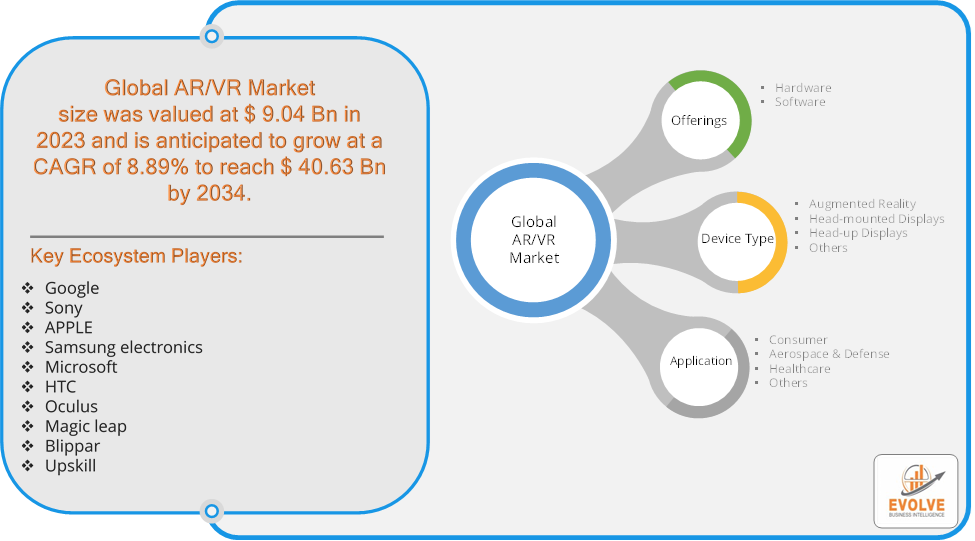Evolve Business Intelligence has published a research report on the Global AR/VR Market, 2021–2034. The global AR/VR market is projected to exhibit a CAGR of around 4.41%during the forecast period of 2021 to 2034.
Evolve Business Intelligence has recognized the following companies as the key players in the global AR/VR Market: Google, Sony, APPLE, Samsung electronics, Microsoft, HTC, Oculus, Magic leap, Blippar, Upskill..
The AR/VR Market size accounted for USD 9.04 Billion in 2023 and is estimated to account for 10.21 Billion in 2024. The Market is expected to reach USD 40.63 Billion by 2034 growing at a compound annual growth rate (CAGR) of 8.89% from 2024 to 2034. The immersive technologies that combine digital material with the real or virtual world are the main focus of the AR/VR (Augmented Reality/Virtual Reality) business. While VR develops entirely simulated settings for consumers to experience, AR overlays digital elements in a real-world environment to enhance user interaction. The industry is primarily driven by improvements in hardware, 5G, and the growing number of use cases in industries including gaming, healthcare, education, and retail. Due to the growth of remote work, virtual collaboration, and entertainment needs, both AR and VR are becoming more and more popular. High expenses, privacy issues, and obstacles to content development are major issues.
Download the full report now to discover market trends, opportunities, and strategies for success.
Segmental Analysis
The global AR/VR market has been segmented based on Offerings, Device Type, Application
Based on the Offerings, the market is segmented based on Hardware, Software. the Hardware segment currently dominates, driven by the demand for advanced headsets, sensors, and other physical devices essential for immersive experiences. However, the Software segment is rapidly growing, fueled by increasing content creation and application development across various industries.
Based on the Device Type, the market has been divided into Augmented Reality, Head-mounted Displays, Head-up Displays, Others. Head-mounted Displays (HMDs) dominate the segment based on device type, largely due to their widespread use in gaming, training, and immersive experiences. Augmented Reality devices also show strong growth, particularly in mobile applications and industrial use cases.
Based on Application, the market has been divided into Consumer, Aerospace & Defense, Healthcare, Others. the Healthcare segment currently dominates due to its extensive applications in training, surgical simulations, and patient treatment, driven by the demand for innovative solutions in medical education and therapy. Following closely are Consumer applications, particularly in gaming and retail, which also exhibit significant growth potential.
Regional Analysis
The AR/VR market is divided into five regions: North America, Europe, Asia-Pacific, South America, and the Middle East, &Africa. North America dominates the AR/VR market due to several factors. Throughout the projected period, North America is anticipated to develop at the quickest rate among regional markets. This is because virtual reality technology is being widely used in a variety of applications across a wide range of industry sectors, especially the gaming and automotive industries. The greater number of gamers in Europe helps explain why cutting-edge VR headsets are more popular there. The expansion of the regional market has been accelerated by the rapid development and distribution of powerful VR hardware sets aimed at the gaming community. The Asia-Pacific region has been witnessing remarkable growth in recent years. Due to continuous improvements in VR technology, Asia-Pacific reported the greatest revenue share in the AR/VR market in 2021. Due to China’s prominence as a distributor of HMDs and other VR-related gear, the country’s VR sector has experienced tremendous growth. Southeast Asian countries’ markets are expanding thanks in part to technological advancements. Telecom providers have been using strategic creativity to offer augmented reality and virtual reality watching platforms that utilize 5G connectivity since Japan began commercial 5G services in 2019.

